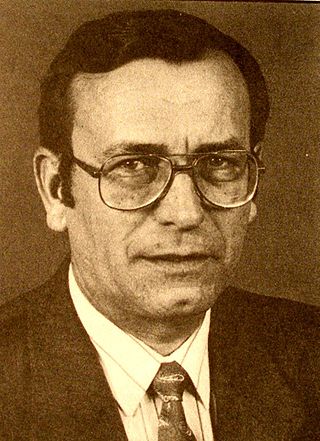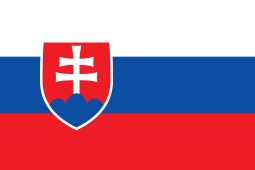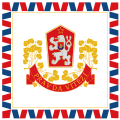
Czechoslovakia was a landlocked state in Central Europe, created in 1918, when it declared its independence from Austria-Hungary. In 1938, after the Munich Agreement, the Sudetenland became part of Nazi Germany, while the country lost further territories to Hungary and Poland. Between 1939 and 1945, the state ceased to exist, as Slovakia proclaimed its independence and Carpathian Ruthenia became part of Hungary, while the German Protectorate of Bohemia and Moravia was proclaimed in the remainder of the Czech Lands. In 1939, after the outbreak of World War II, former Czechoslovak President Edvard Beneš formed a government-in-exile and sought recognition from the Allies.

The national flag of Slovenia features three equal horizontal bands of white (top), blue, and red, with the coat of arms of Slovenia located in the upper hoist side of the flag centred in the white and blue bands. The coat of arms is a shield with the image of Mount Triglav, Slovenia's highest peak, in white against a blue background at the centre; beneath it are two wavy blue lines representing the Adriatic Sea and local rivers, and above it are three six-pointed golden stars arranged in an inverted triangle which are taken from the coat of arms of the Counts of Celje, the great Slovene dynastic house of the late 14th and early 15th centuries.

The pan-Slavic colors—blue, white and red—were defined by the Prague Slavic Congress, 1848, based on the symbolism of the colors of the flag of Russia, which was introduced in the late 17th century. Historically, many Slavic nations and states adopted flags and other national symbols that used some combination of those three colors. Slavic countries that use or have used the colors include Russia, Yugoslavia, Czechoslovakia, Czech Republic, Slovakia, Croatia, Serbia and Slovenia, whereas Belarus, Bosnia and Herzegovina, Bulgaria, Montenegro, North Macedonia, Poland and Ukraine use different color schemes.

The national flag of Croatia or The Tricolour is one of the state symbols of Croatia. It consists of three equal size, horizontal stripes in colours red, white and blue. In the middle is the coat of arms of Croatia.

The national flag of Hungary is a horizontal tricolour of red, white and green. In this exact form, it has been the official flag of Hungary since 23 May 1957. The flag's form originates from national republican movements of the 18th and 19th centuries, while its colours are from the Middle Ages. The current Hungarian tricolour flag is the same as the republican movement flag of the United Kingdom and the colours in that form were already used at least since the coronation of Leopold II in 1790, predating the first use of the Cispadane Republic's tricolour in 1797.

Gustáv Husák was a Czechoslovak politician who served as the long-time First Secretary of the Communist Party of Czechoslovakia from 1969 to 1987 and the President of Czechoslovakia from 1975 to 1989.

The flag of the Czech Republic is the same as the flag of the former Czechoslovakia. Upon the dissolution of Czechoslovakia in December 1992, the Czech Republic kept the Czechoslovak flag while Slovakia adopted its own flag. The first flag of Czechoslovakia was based on the flag of Bohemia and was white over red. This was almost identical to the flag of Poland, so a blue triangle was added at the hoist in 1920. The flag was banned by the Nazis in 1939 as they established a government nominally in control of Bohemia and Moravia, and a horizontal tricolour of white, red, and blue was used for the duration of the war. The 1920–1939 flag was restored in 1945.

The national flag of Ukraine consists of equally sized horizontal bands of blue and yellow.

The dissolution of Czechoslovakia, which took effect on December 31, 1992, was the self-determined secession of the federal republic of Czechoslovakia into the independent countries of the Czech Republic and Slovakia. Both mirrored the Czech Socialist Republic and the Slovak Socialist Republic, which had been created in 1969 as the constituent states of the Czechoslovak Socialist Republic until the end of 1989.

The Czechoslovak Socialist Republic, known from 1948 to 1960 as the Czechoslovak Republic, Fourth Czechoslovak Republic, or simply Czechoslovakia, was the Czechoslovak state from 1948 until 1989, when the country was under communist rule, and was regarded as a satellite state in the Soviet sphere of interest.

The coat of arms of the Slovak Republic consists of a red (gules) shield, in early Gothic style, charged with a silver (argent) double cross standing on the middle peak of a dark blue mountain consisting of three peaks. Extremities of the cross are amplified, and its ends are concaved. The double cross is a symbol of its Christian faith and the hills represent three symbolic mountain ranges: Tatra, Fatra, and Matra.

The coat of arms of Czechoslovakia were changed many times during Czechoslovakia’s history, some alongside each other. This reflects the turbulent history of the country and a wish to use appropriate territorial coats of arms.

Czechoslovakism is a concept which underlines reciprocity of the Czechs and the Slovaks. It is best known as an ideology which holds that there is one Czechoslovak nation, though it might also appear as a political program of two nations living in one common state. The climax of Czechoslovakism fell on 1918-1938, when as a one-nation-theory it became the official political doctrine of Czechoslovakia; its best known representative was Tomáš Masaryk. Today Czechoslovakism as political concept or ideology is almost defunct; its remnant is a general sentiment of cultural affinity, present among many Czechs and Slovaks.

The coat of arms of Carpatho-Ukraine is the official heraldic coat of arms of Zakarpattia Oblast in Ukraine. The coat of arms was initially adopted on 30 March 1920 along with coat of arms of other lands of Czechoslovakia. The Ukrainian version of the arms was adopted on 18 December 1990 as a revived coat of arms by Hungarian graphic artist Janos Reiti.
Jiří Louda was a Czech heraldist and veteran of World War II. Louda was considered among the leading designers of coats of arms in the Czech Republic and the former Czechoslovakia. He designed the current coat of arms of the Czech Republic, adopted in 1992, which incorporates the displays of the three historic Czech lands. Louda also designed the standard of President of the Czech Republic, which was adopted in 1993 following the country's independence. Additionally, Louda created the coat of arms of the Olomouc Region, as well as the municipal coats of arms for more than 200 towns and cities throughout the Czech Republic.

Ladislav Čisárik was a Slovak heraldic artist, painter, and graphic designer. In 1990, Ladislav Čisárik and Ladislav Vrtel co-designed the coat of arms of Slovakia, the current flag of Slovakia, and the presidential standard of the president of Slovakia. He also designed or modified the coat of arms and seals for more than 100 towns and municipalities in Slovakia.

Imrich Andrejčák was a Czechoslovak-born Slovak army general and politician. He was the last Minister of Defence of Czechoslovakia from 2 July 1992 until 31 December 1992, with the dissolution of the country. Andrejčák then became the first Defence Minister of an independent Slovakia from 16 March 1993 and 14 March 1994.

Slovak heraldry is the study and practice of heraldry in the territory of Slovakia.
 Another flag used during the Slovak Uprising. Basically historical flag of Hungary with green replaced by blue. The first depiction of the hills in coat of arms in blue color
Another flag used during the Slovak Uprising. Basically historical flag of Hungary with green replaced by blue. The first depiction of the hills in coat of arms in blue color One of the more popular flags used by slovak volunteers during Slovak Uprising 1848. Flags from this period introduced blue color into the slovak flag for the first time, after the Slavic Congress. Used also as flag of Slovak National Council
One of the more popular flags used by slovak volunteers during Slovak Uprising 1848. Flags from this period introduced blue color into the slovak flag for the first time, after the Slavic Congress. Used also as flag of Slovak National Council  Official flag of the
Official flag of the




































